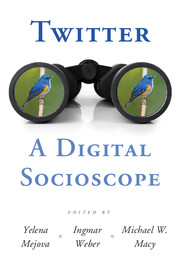Introduction
Published online by Cambridge University Press: 05 May 2015
Summary
[J]ust as the invention of the telescope revolutionized the study of the heavens, so too by rendering the unmeasurable measurable, the technological revolution in mobile, Web, and Internet communications has the potential to revolutionize our understanding of ourselves and how we interact… [T]hree hundred years after Alexander Pope argued that the proper study of mankind should lie not in the heavens but in ourselves, we have finally found our telescope. Let the revolution begin….
– Duncan Watts (2012, p. 266)Online interaction is now a regular part of daily life for a demographically diverse population of billions of people worldwide. Facebook and Twitter are two of the most popular places where these interactions take place. A key difference is that most content on Twitter is publicly accessible via the Twitter API or through data resellers such as GNIP and Datasift, whereas most Facebook content is private. Thus, Twitter has emerged as the single most powerful “socioscope” available to social scientists for collecting fine-grained time-stamped records of human behavior and social interaction at the level of individual events. These data are also global in scale, allowing researchers to address fundamental questions about social identity, status, conflict, cooperation, collective action, and diffusion. This unprecedented opportunity comes with a number of methodological challenges, including generalizing observations to the offline world, protecting individual privacy, and solving the logistical challenges posed by “big data.” This introductory chapter reviews current advances in online social research and critically assesses the theoretical and methodological opportunities and limitations.
Opportunities and Challenges for Online Social Research
Scientific disciplines make revolutionary advances not only through new discoveries, theories, and paradigms, but also because of the invention of new tools and methodologies (Kuhn, 1962). The electron microscope, space telescope, particle accelerator, and magnetic resonance imaging (MRI) have allowed scientists to observe the world at greater scale or at finer resolution, revealing previously obscured details and unexpected patterns and experiencing the “eureka moments” of scientific breakthroughs.
- Type
- Chapter
- Information
- Twitter: A Digital Socioscope , pp. 1 - 20Publisher: Cambridge University PressPrint publication year: 2015
References
- 2
- Cited by



